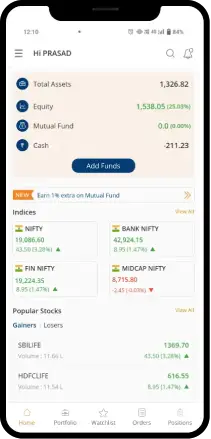
Table of content
Exploring Optimal Tax-Saving Avenues in India for the New FY
As we embark on the financial journey of the new fiscal year, it's crucial to have financial products in your portfolio that not only secure your investments but also optimise your tax savings. Due to the presence of a vast array of such options, the choice can be confusing. Investors are always in a dilemma regarding the right tax saving option to choose that aligns with their individual financial goals. In this comprehensive guide, we delve into the diverse landscape of tax-saving investments in India for the financial year 2024-25. From traditional instruments to modern avenues, we'll navigate the array of options to help you make informed choices tailored to your financial objectives.
Employee Provident Fund (EPF)
Let us kick start our journey with some of the best tax saving options that are backed by the Government of India, thus offering higher stability and reliability. Salaried employees must be well aware of the Employee Provident Fund (EPF). It is a mandatory savings scheme for salaried individuals wherein both the employer and employee contribute towards the provident fund. It is usually 12% of the basic amount of the employee. EPF not only builds a retirement corpus but also qualifies for tax deductions. The scheme is mandatory for all employers with over 20 people on their payroll, however, those with a lesser number of employees can also choose to incorporate EPF in their pay structure. An off-shoot of the EPF is the VPF – Voluntary Provident Fund. Many organisations allow employees to contribute additional amounts from their own salary that can add to their overall EPF corpus.
Key Features and Benefits of EPF:
- Employee contributions are eligible for deductions under Section 80C with a limit of ₹ 1.5 Lakhs per fiscal year. This is true for both EPF and VPF combined.
- Interest earned is tax-exempt.
- Withdrawals are tax-free if the account is held for at least 5 years.
- The interest rate is set by the government and reviewed each year.
- Do note; recently, the government introduced a new tax clause on EPF investments. Under this, an employee's contribution above ₹ 2.5 Lakhs in a financial year will be subject to taxation as per their existing tax slab rate.
Public Provident Fund (PPF)
What about those who are not salaried or their employer does not offer the EPF option? Public Provident Fund – PPF for short – continues to be a cornerstone of tax-saving strategies, providing a winning combination of safety, tax benefits, and compounding returns. The long tenure and fixed interest rates make it a reliable choice for risk-averse investors who cannot avail of or do not wish to contribute additionally to their EPF.
Key Features and Benefits of EPF:
- PPF has a lock-in period of 15 years, providing a disciplined approach to long-term wealth creation.
- Contributions to PPF are eligible for deductions under Section 80C up to a limit of ₹ 1.5 Lakhs per annum.
- Like the EPF, interest earned and maturity proceeds are tax-free here as well, making it an Exempt-Exempt-Exempt (EEE) category tax saving option.
National Pension System (NPS)
The National Pension Scheme is a voluntary, long-term retirement savings plan. It combines the elements of retirement planning and tax savings, allowing individuals to build a corpus for their post-retirement years. People employed in the public and private sectors can opt for NPS. Professionals, who are not on the payroll of any organisation, or unemployed individuals can also opt for NPS through the option of voluntary-individual contribution.
Key Features and Benefits of EPF:
- NPS allows investment in equity and debt instruments, providing market-linked returns. Hence, there are market-related risks as well.
- Contributions qualify for deductions under Section 80CCD(1) and 80CCD(1B).
- Additionally, there's an additional deduction for self-contribution up to ₹ 50,000 under Section 80CCD(2). This amount is over the combined limit of Section 80C, making NPS one of the best tax saving instruments for those in a higher tax bracket and who may have exhausted their limits for other tax saving avenues.
- Since, the NPS is a pension plan, it comes with an annuity clause as well. It is important to understand the terms and conditions carefully due to its long lock-in period.
- To summarise, after the age of 60, you can only withdraw (in lump sum) 60% of your corpus, which will be tax exempt. The remaining 40% needs to be used to purchase annuities for a fixed, regular, income. The returns on this may be taxable.
Sukanya Samriddhi Yojana (SSY)
Designed exclusively for the girl child, SSY ensures systematic savings for her future education and marriage expenses. With a sovereign guarantee and attractive interest rates, this scheme serves as a secure and tax-efficient investment option.
Key Features and Benefits of EPF:
- SSY aims to secure the financial future of girl children by offering a dedicated savings platform.
- Contributions made towards SSY are eligible for deductions under Section 80C.
- SSY is a EEE category scheme, which means, the interest earned is exempted from tax as is the maturity amount.
Senior Citizen Savings Scheme (SCSS)
SCSS caters to the unique needs of senior citizens by offering higher interest rates and quarterly payouts. With tax benefits under Section 80C, it stands out as a tax-efficient investment avenue for those in their golden years.
Key Features and Benefits of EPF:
- SCSS is exclusively for individuals aged 60 years and above. However, people who have retired via the Voluntary Retirement Scheme (VRS) or Superannuation can apply between the ages of 55 to 60 years. Retired defence employees can apply between the ages of 50 to 60 years.
- Investments in SCSS are eligible for deductions under Section 80C.
- The interest earned on this investment is taxable, and paid quarterly.
- To aid senior citizens, no TDS is deducted if the interest earned in a financial year is under ₹ 50K.
- Recently, the government has increased the investment limit for the SCSS to ₹ 30 Lakhs.
- The investment tenure is five years, however, you can extend the tenure by another three years.
National Savings Certificate (NSC)
NSC is a popular, traditional tax saving option. It is backed by the government and provides a safe avenue for tax-saving investments. The fixed interest rates and guaranteed returns make it an attractive choice for risk-averse investors seeking stable returns with tax benefits.
Key Features and Benefits of EPF:
- NSC provides a fixed interest rate, ensuring predictable returns.
- Investments in NSC are eligible for deductions under Section 80C.
- However, interest accrues annually and is deemed reinvested, making it taxable.
- No TDS is deducted in NSC, and you are responsible for paying the applicable tax (if any) while filing your income tax returns.
Tax-Saver Fixed Deposit Scheme
It is expected to see a host of government-backed financial products in this list. But these are not the only tax saving instruments available to you. Fixed deposits offered by public and private banks can also provide a familiar and secure option for tax-conscious investors. With a fixed tenure and predetermined interest rates, these deposits offer assured returns while qualifying for tax deductions under Section 80C.
Key Features and Benefits of EPF:
- Tax-Saver FDs are tax exempt up to ₹ 1.5 Lakhs under Section 80C.
- The lock-in period is five years.
- Interest is taxable at the hands of the primary owner of the FD.
- Maturity amount is taxable as well, in the financial year the FD matures.
- An interest amount of up to ₹ 40K (₹ 50K for senior citizens) is exempted from TDS deduction.
Life Insurance Policy
Life insurance policies, such as endowment and money-back plans, provide a dual benefit of life coverage and savings. Although life insurance is a way to safeguard the future of your loved ones in your absence, premiums paid are eligible for tax deductions, making these policies a versatile tax-saving tool.
Key Features and Benefits of EPF:
- Premiums paid for life insurance policies are eligible for deductions under Section 80C.
- Maturity proceeds are also tax-exempt under Section 10(10D).
Unit Linked Insurance Plan (ULIP)
ULIPs are an enhanced hybrid version of the traditional life insurance. They not only provide life insurance coverage but also offer the added advantage of wealth creation through market-linked returns. With a portion of the premium allocated to equity and debt funds, ULIPs cater to both protection needs and long-term financial growth.
Key Features and Benefits of EPF:
- Premiums paid towards ULIPs qualify for deductions under Section 80C.
- The maturity amount is exempt from tax under Section 10(10D), subject to conditions.
- ULIPs offer flexibility to reallocate your premium in the underlying assets for a more dynamic asset mix.
Equity-Linked Savings Scheme (ELSS) Mutual Fund
ELSS mutual funds blend tax efficiency with the potential for higher returns by primarily investing in equities. The three-year lock-in period ensures a disciplined investment approach, and the returns are eligible for tax-free withdrawals.
Key Features and Benefits of EPF:
- ELSS funds predominantly invest in equities, offering growth opportunities.
- The returns of ELSS, historically, have been higher than most tax saving instruments. But historic performance is no guarantee for future returns.
- Investments in ELSS are eligible for deductions under Section 80C, with a lock-in period of 3 years.





